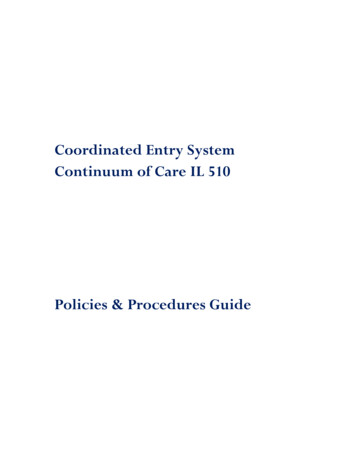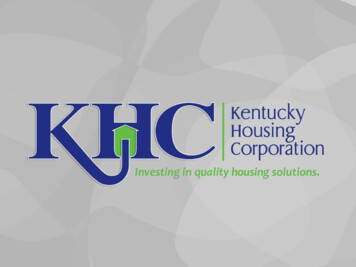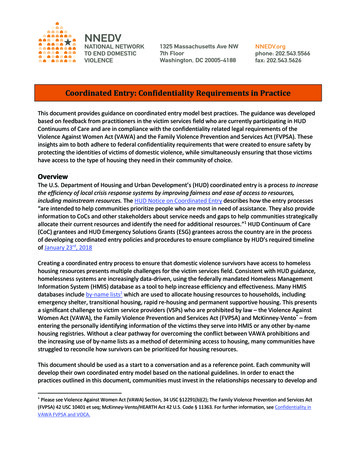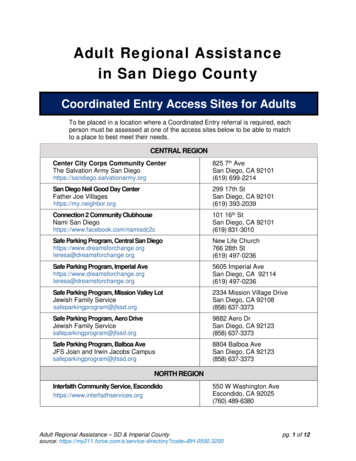
Transcription
Health Centers and Coordinated Entry:How and Why to Engage with LocalHomeless SystemsINTRODUCTIONHealth center program grantees know the catchphrase, “housing is a social determinant ofhealth,” and many have begun to try to assess and address patients’ housing challenges inorder to improve health outcomes. A critical tool available to health centers lies ‘outsidethe four walls’ of the health center in local homeless coordinated entry systems 1, whichprovide for a more centralized and coordinated approach to a community’s homeless crisisresponse system. In short, coordinated entry systems are meant to streamline access tohousing options for homeless and at-risk individuals and families in a given geographicregion. Health centers serving homeless patients (1,159 health centers served 1,191,772individuals experiencing homelessness in 2015) 2 are ideal partners for coordinated entrysystems. This brief will provide information for health center program grantees on whatcoordinated entry is meant to be, how and why to partner with these systems, and willdemonstrate both methods and effectiveness of this effort through case examples from thefield.COORDINATED ENTRY: INTERVENTIONS & ASSESSMENTSThe federal Department of Housing and Urban Development (HUD) requires localContinuums of Care (CoCs) to develop a “comprehensive crisis response system in eachcommunity [using] new and innovative types of system coordination,” with the goal of“increasing the efficiency of local crisis response systems and improving fairness and easeof access to resources.” 3 Coordinated entry processes are intended to help communitiesprioritize people who are most in need of assistance, e.g. the chronically homeless and/orthe most vulnerable in need of housing and supports. Prioritization for housing should takeinto account a variety of factors, including physical and behavioral health challenges orfunctional impairments. Of particular relevance to health centers, HUD recently issued anotice for CoCs that included guidance recommending that local CoCs should includemainstream service providers, including providers of physical and behavioral healthservices – a clear fit for our nation’s network of health centers – in activities related tocoordinated entry.These systems’ names can vary locally, and commonly used terms include coordinatedentry/assessment/access. For the purposes of this publication, we refer to coordinated entry systems.2 According to the Uniform Data System (UDS) Of the 1375 Health Center Program Grantees in 2015, 1159reported serving at least one person experiencing homelessness. The number of homeless individuals servedby a health center varies greatly and ranges from 1 to 31,093. Of the remaining health centers, 45 left thisvalue blank in UDS and 171 reported ‘0.’ “Anecdotally, not all health centers reported this informationconsistently, so the number can potentially be underreported at some health centers.3 HUD guidance on coordinated entry can be found in the recent CPD-17-01 Notice Establishing AdditionalRequirements for a Continuum of Care Centralized or Coordinated Assessment rdinated-Assessment-System.pdf1
These activities include:identification of people experiencing or at risk of homelessnessfacilitating referrals to and from the coordinated entry processaligning prioritization criteria where applicablecoordinating services and assistanceconducting activities related to continual process improvement. 4In order to understand why it is important to engage with coordinated entry, healthcenters need to understand the resources available for homeless individuals. HUD fundsCoCs to provide four basic types of homeless assistance:Permanent Supportive Housing 5 - Permanent supportive housing, also referred to as PSHor simply supportive housing, pairs non-time limited housing and rental assistance, withsupportive services so that people experiencing homelessness with a disability (usuallybroadly defined) can maintain stability in the community. HUD strongly encourages, and insome cases requires, that HUD-funded PSH prioritize individuals and families who are“chronically homeless” for this type of housing. However, it should be noted that HUD is notthe only source of funding for supportive housing, as many states and local governments,alongside foundations, hospitals, and other sources fund this type of intervention as well.Rapid Re-housing – Rapid re-housing (sometimes referred to as RRH) is a type ofpermanent housing that emphasizes assistance with housing search and relocation serviceswith short- to medium-term rental assistance. This type of assistance is generally seen as abetter fit for families and less vulnerable individuals experiencing shorter terms ofhomelessness. Rapid re-housing can also be used to serve chronically homeless individualsand families as an alternative to transitional housing or while waiting for a PSH unit tobecome available.Transitional Housing – Transitional housing provides up to 24 months of housing withaccompanying supportive services. It is meant to provide homeless individuals and familieswith the interim stability and support to successfully move to and maintain permanenthousing. It should be noted that with a policy emphasis towards permanent housing andvarious funding incentives from HUD, the total number of transitional housing unitsavailable in CoCs decreased by 21% between 2013 and 2016, while the number of slots ofpermanent supportive housing has trended upwards by 24% over the same period. 6Emergency Shelter and Street Outreach Services – Funded through EmergencySolutions Grants, these services are meant to serve as the “front line” for peopleexperiencing homelessness in communities. Shelter should be used as a bridge c-program-eligibility-requirements/6 CoC Housing Inventory Count Reports, All States, Territories, Puerto Rico, and DC, c/coc-housing-inventory-countreports/?filter Year 2013&filter Scope &filter State &filter CoC &program CoC&group HIC452 Page
permanency while people are being connected with, for example, apartments for PSH.Shelter is not appropriate as a long term solution to homelessness.One of the primary functions of a coordinated entry system is to allocate the above housingresources appropriately and fairly. In the past, homeless consumers often had to sign up onmultiple supportive housing program waitlists, and were left to find an available shelterbed on their own. This was ineffective, as it was left to the individual to navigate a myriadof programs. Now, with coordinated entry, HUD mandates that communities use astandardized assessment approach on all presenting individuals and families to determinehousehold vulnerability and eligibility for housing resources, to organize a waitlist, and toprovide access to shelter and housing slots via one intake process. The assessment tool (ortools) should be administered to all presenting clients/patients, and may provide a score ofsome type to help sort the waitlist by “vulnerability.” In other words, those who are themost vulnerable receive prioritized referrals to supportive housing and other resourcesfirst as they become available. Individual housing programs or initiatives withincoordinated entry may have additional criteria, such as identification as a “high utilizer” or“frequent user” of emergency crisis services as determined through matchedadministrative data. A strong coordinated entry process will also work to incorporate otherhousing options for referral for those in need, but possibly lower in vulnerabilities.While HUD does not mandate or recommend a specific assessment tool, many communitiesuse some version of the Vulnerability Index – Service Prioritization Decision AssistanceTool, or VI-SPDAT. 7 This is a combination of two tools – the Vulnerability Index created forstreet outreach that helps to determine the vulnerability of street homeless individuals,and the SPDAT created as an intake and management tool. 8 Typically this tool involves aninitial pre-screening followed by a more in-depth assessment. Another tool in use is theVulnerability Assessment Tool 9 (VAT) developed by DESC in Seattle, WA. Finally, somecommunities, such as Baltimore (see Baltimore example, below) have developed their owntool based on local input and priorities. Detailed specifics of these assessment tools arebeyond the scope of this brief, it is however important for health centers to understand thatthe tools ask questions along a few critical domains such as: mortality risk, medical risk,mental health and substance use needs, social behaviors, organization/orientation, andextent of homelessness. The answers are self-reported from the client and are used toprioritize the household for assistance.While the effort to build coordinated entry can have significant impact helping acommunity to prioritize resources and more effectively meet the needs of vulnerableindividuals and families, it does not on its own increase the resources – supportive housingunits and services. The knowledge gained through a coordinated entry planning andimplementation process is valuable and vital in any next step efforts to justify the need toexpand the volume of units and resources available for supportive 2014/08/VI-SPDAT-Manual-2014-v1.pdf9 http://desc.org/research.html783 Page
Figure 1: Coordinated Entry4 Page
ROLES FOR HEALTH CENTERSMany health centers – especially Health Care for the Homeless (HCH) grantees – are awareof coordinated entry processes locally, yet not involved actively in their operation orgovernance. There are many ways in which becoming involved can not only benefit thehealth center operations and patients, but can also help the homeless system organizations.Some HCH grantees operate supportive housing and other programs funded by HUD, andtherefore are required to participate in local coordinated entry processes. They’ve reportedthat doing so has had some real benefits: Easier referrals to housing: Health center staff is able to refer patients to thehomeless system with less effort. Instead of making calls to multiple housingproviders, the staff simply makes one call to an intake/assessment site where theperson can be assessed and connected to the appropriate resource.Reduce the “black box” quality of homeless systems: Some health centers reportfeeling “out of the loop” from homeless systems, even though they are working withthe same people. Working with the CoC entities the health center can be betterconnected and coordinate efforts with other organizations working with the samepatients/clients, and the health center can be part of a community’s efforts to endhomelessness.Providing a medical perspective on need: Health centers may have a differentperspective on what makes a patient “medically vulnerable.” Health centers with aseat at the table of the Continuum of Care’s coordinated entry governing committeescan have say in how consumers are targeted and prioritized locally.Opportunities for patient engagement: Health centers are a place where clients cannot only be assessed for housing eligibility, but a place where they may be seekingother services, such as primary and behavioral health services. This introductionpresents an opportunity for engagement of clients/patients who may be resistingefforts by street outreach workers, resulting in quicker connections to housingresources. Health centers can execute MOUs with CoC organizations to make thiscoordination easier to discuss across systems.Health centers can link into coordinated entry in a variety of ways. Some were detailedabove from the recent HUD Notice. Beyond assistance with identification, referrals, servicecoordination and governance activities, it is important to recognize that health centershave unique resources and relationships with clients/patients that can greatly benefitcoordinated entry. These include: Health centers can serve as an intake hub where pre-screenings and assessmentstake place. Coordinated entry intake workers can be placed inside health centers fora streamlined engagement and screening process.Health center workers and homeless service providers can collaborate to locatevulnerable people, and vice versa (see example from Richmond). This collaborationis mutually beneficial, helping understaffed homeless outreach teams locate andhealth center staff engage clients in care, potentially resulting in quicker placementinto housing.5 Page
Health center data systems may have information to help document a patient’sdisability and length of homelessness, which needs to be established in order toqualify for HUD-funded supportive housing.Health centers can be part of care coordination teams once people are housed tohelp ensure fewer returns to homelessness and a continuation of healthimprovements brought on by stable housing.EXAMPLES FROM THE FIELDHealth Care for the Homeless (HCH), Baltimore, MDIn Baltimore, coordinated entry launched in 2013 and the Health Care for the Homelessprogram had a seat at the table right away. HCH participated as a provider of PermanentSupportive Housing and a ‘navigator’ entity, which trained key staff to assist individualsthrough the coordinated entry process. The Baltimore CoC began using a locally-createdtool, the Baltimore Decision Assessment Tool, based on the Vulnerability Index. TheBaltimore HCH assisted in building and testing the tool as well as training navigators to usethe tool, to reinforce the need for consumer-appropriate language. HCH staff served oncoordinated entry work groups and participated as a testing site for a new system withinthe Homeless Management Information System (HMIS.) The integration of coordinatedentry into the HMIS, occurring later in 2017, will improve coordination and access tohousing resources for individuals experiencing homelessness. Baltimore HCH staff isuniquely positioned to participate in coordinated entry, feeling the knowledge they possesson health and experience asking sensitive questions make them an ideal solution tomeasuring vulnerability and housing needs for the homeless system. Staff also play a role inengaging hard to reach consumers over time, as they have an ability to follow up withclients using case management and outreach services. Health center staff use theElectronic Health Record to document homeless status and complete ‘housing plans’ withclient consent. This documentation is used for homeless verification and follow-up stepsfor the individuals.As an early participant in coordinated entry, the Baltimore HCH learned some valuablelessons to impart to other health center program grantees. They advise obtaining access tothe CoC’s Homeless Management Information System (HMIS); executing MOUs withparticipating agencies to ensure ease of service coordination for those individuals in PSHwho are utilizing health center services; and obtaining trainings relevant to thecoordinated entry process, including documentation of chronic homelessness andidentification assistance, HMIS system procedures, and Housing First methodology. Finally,health center EHRs contain valuable information and notes on homelessness status anddisability. If client consent is obtained, leveraging this information can help to documentchronic homelessness and assist in the housing process.Equipped with the right tools and community partnerships, health center staff are greatadvocates to prioritize vulnerable health center clients for supportive housing throughcoordinated entry, resulting in a faster path to stability and improved health outcomes.6 Page
Daily Planet in Richmond, VAThe Daily Planet is a HCH grantee in Richmond, and offers medical respite and a Safe Havenprogram that provides a temporary stay for clients targeted for supportive housing, inaddition to comprehensive and integrated healthcare to those who are homeless, or at riskof homelessness. Daily Planet’s foray into supportive housing began in 2010 when apartnership with Virginia Supportive Housing led to a 3-year Cooperative Agreement toBenefit Homeless (CABHI) grant from SAMHSA to continue the work of the 100,000 Homesinitiative 10. This continued partnership with the CoC led to Daily Planet’s activeparticipation the community’s coordinated entry process. They are part of the HousingTeam that meets regularly to identify, prioritize and place individuals into housing. A DailyPlanet outreach coordinator is tasked with leading the outreach efforts of the process.Supportive housing staff and Daily Planet case managers work together to ensure smoothaccess to Daily Planet’s medical, behavioral health services and psychiatric services.Daily Planet’s experience has shown the importance of strong collaboration amongstakeholders across the community provides the key to making coordinated entry work. InRichmond, the police department, behavioral health entities, the local housing authority,hospitals and emergency departments, and the local Veterans Administration, SocialSecurity Administration, and Department of Social Services are all active parties incoordinated entry. Participation from across Richmond’s stakeholders has made fundingfrom various sources more available for supportive housing focused outreach, though casemanagement funding remains a challenge. Other challenges Daily Planet and partners haveworked through are common ones in many communities – finding landlords willing to rentto this vulnerable population, sustaining and maintaining housing, and providingconnections to the community so residents don’t feel isolated. In summary, Helena DeLigt,COO for Programs at Daily Planet recommends health centers get involved withcoordinated assessment in order to move towards a common understanding ofprioritization of housing resources in the community and to ensure the health centerperspective is heard and improve accessibility to your services10http://100khomes.org7 Page
SOME FINAL TIPS FOR GETTING STARTEDSo, where to begin? First, determine where your community is on coordinated entryimplementation. Jurisdictions are at varying stages of coordinated entry in termsgeographic, population, and intervention implementation. HUD requires all communities tobe in compliance by February 2018, so most are in various stages of planning andimplementation in order to be on board by that time. Some items to put on your list to getstarted are below.Engage the governing leadership: As a health center, you will want to engage coordinatedentry leadership in order to discuss your regular involvement and role. Coordinated entryprocesses should have regular governance meetings, which you can attend.Data: If your health center eventually becomes an intake site where housing screenings andassessments are done, you will want to explore becoming a user of the CoC’s HomelessManagement Information System (HMIS) to be able to enter data and perform look ups.Ask about the process for becoming a user, and take a look at the CoC’s Release ofInformation form signed by clients.MOUs: In order to discuss the needs of specific patients, you will likely need an MOU withparticipating service providers.Consider carefully your role(s): As stated in the HUD guidance 11 and repeated below, thereare many ways to participate in a community’s coordinated entry. You can do one or more– attending regular meetings will help you discover where the gaps are in the system andwhere your health center can help.identification of people experiencing or at risk of homelessnessfacilitating referrals to and from the coordinated entry processaligning prioritization criteria where applicablecoordinating services and assistanceconducting activities related to continual process improvement.Perseverance: A coordinated entry system does not solve the issue of supply of qualitysupportive housing, but rather prioritizing scarce resources to stabilize and address theneeds of the most vulnerable. Health Center participation in the development andimplementation process of coordinated entry can be messy as multiple priorities arediscussed and incorporated, but the end result can be a comprehensive system thatconnects a broad range of Coordinated-Assessment-System.pdf118 Page
ABOUT CSHCSH transforms how communities use housing solutions to improve the lives of the mostvulnerable people. We offer capital, expertise, information and innovation that allow ourpartners to use supportive housing to achieve stability, strength and success for the peoplein most need. CSH blends over 20 years of experience and dedication with a practical andentrepreneurial spirit, making us the source for housing solutions. CSH is an industryleader with national influence and deep connections in a growing number of localcommunities. We are headquartered in New York City with staff stationed in more than 20locations around the country. Visit csh.org to learn how CSH has and can make a differencewhere you live.“This project was supported by the Health Resources and Services Administration (HRSA) of the U.S. Departmentof Health and Human Services (HHS) under cooperative agreement number # U30CS26935, Training andTechnical Assistance National Cooperative Agreement (NCA) for 325,000 with 0% of the total NCA projectfinanced with non-federal sources. This information or content and conclusions are those of the author andshould not be construed as the official position or policy of, nor should any endorsements be inferred by HRSA,HHS or the U.S. Government.”9 Page
response system. In short, coordinated entry systems are meant to streamline access to housing options for homeless and at-risk individuals and families in a given geographic region. Health centers serving homeless patients (1,159 health centers served 1,191,772 individuals experiencing homelessness in 2015)2 are ideal partners for coordinated .










